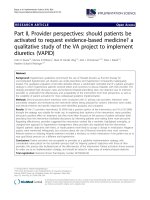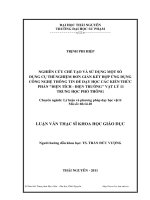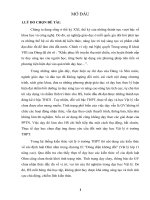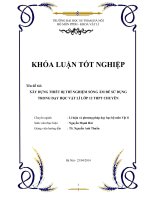Bài giảng Y học: Xây dựng câu hỏi lâm sàng PICO
Bạn đang xem bản rút gọn của tài liệu. Xem và tải ngay bản đầy đủ của tài liệu tại đây (298.89 KB, 15 trang )
Xây dựng câu hỏi lâm sàng
PICO
Sheila Snow-Croft
NN/LM SE/A
Taken in part from the tutorial developed by Connie Schardt, Duke
University Medical Center Library and Jill Mayer, University of North
Carolina at Chapel Hill Health Sciences Library, at
/>
"Evidencebased medicine is the integration of best
research evidence with clinical expertise and
patient values."
Sackett, D. L. (2000). Evidencebased medicine: How
to practice and teach EBM(2nd ed.). Edinburgh; New
Y ork: Churchill Livingstone.
Evidence-Based Medicine (EBM)
Evidence-Based Practice (EBP)
Evidence-Based Clinical Practice (EBCP)
Evidence-Based Health Care (EBHC)
Evidence-Based Nursing (EBN)
Sackett’s definition refers to all of these;
EBP and EBHC are more universally used.
EBP:
1. Assess the patient
2. Ask the question
3. Acquire the evidence
4. Appraise the evidence
5. Apply: talk with the
patient
(from Introduction to Evidence Based
Practice tutorial)
EBM:
1. Ask focused question
2. Find the evidence
3. Appraise the evidence
4. Make a decision
5. Evaluate performance
(from Centre for Evidence Based Medicine
www.cebm.net)
Clinical expertise: the clinician’s cumulated
experience, education, and clinical skills
Patient values: The patient brings to the
encounter his or her own personal and unique
concerns, expectiations, and values.
Best Research Evidence: usually found in
clinically relevant research that has been conducted
using sound methodology
Forming a question
Identify key patient problem
Phrased to facilitate finding an answer
What treatment might be considered
Alternative treatments to consider
Outcome to avoid or promote
PICO
P=Patient or problem
I =Intervention, prognostic
factor,
or exposure
C=Comparison
O=Outcomes
(T)=Type of Study
Exercises: PICO scenarios
Types of Studies
Case series and Case Reports
Case control studies
Cohort studies
Randomized, controlled clinical
trials
Systematic Reviews
Meta-analysis
Case series and Case reports
Collections of reports on the treatment
of individual patients or a report on a
single patient.
No control groups with which to
compare outcomes, so limited
statistical validity.
Case control studies
Patients who already have a specific condition are
compared with people without the condition.
Researcher looks back to identify factors or exposures
possibly associated with the condition, often relying on
medical records and patient recall.
Less reliable because showing a statistical relationship
does not mean than one factor necessarily caused the
other.
Starts with patients who already have the outcome
and looks backwards to possible exposures.
Cohort studies
Take a large population who are already taking a
particular treatment or have an exposure, follow them
forward over time, and then compare for outcomes
with a similar group that has not been affected by the
treatment or exposure.
Observational and not as reliable as randomized
controlled studies, since the two groups may differ in
ways other than in the variable under study.
Starts with the exposure and follows patients
forward to an outcome.
Randomized, controlled clinical
trials
Carefully planned projects that introduce a treatment
or exposure to study its effect on patients.
Include methodologies that reduce the potential for
bias (randomization and blinding) and allow for
comparison between intervention and control groups.
Is an experiment and can provide sound evidence of
cause and effect.
Randomly assigns exposures and then follows
patients forward to an outcome.
Systematic Reviews
Usually focus on a clinical topic and answer a
specific question. An extensive literature search is
conducted to identify studies with sound
methodology. The studies are reviewed, assessed,
and the results summarized according to the
predetermined criteria of the review question.
Meta-analysis
Thoroughly examines a number of valid studies on a
topic and combines the results using accepted
statistical methodology to report the results as if it
were one large study.
The Cochrane Collaboration has done a lot of work in
the areas of systematic reviews and meta-analysis.









